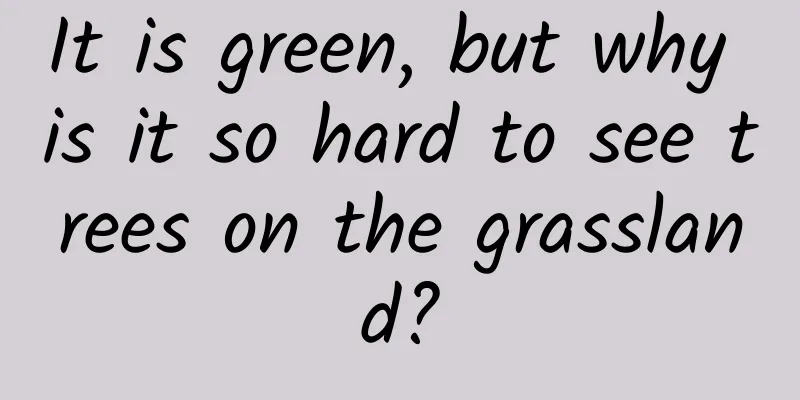It is green, but why is it so hard to see trees on the grassland?

|
Author: Duan Yuechu and Huang Yanhong When we step onto the vast grassland and look around, we see a lush green grass swaying in the wind, like a green ocean, but there are very few trees. This makes us wonder: Why don't trees grow on the grassland? There are actually profound natural science principles behind this, which are closely related to soil, climate, biology and other factors. From the perspective of soil conditions, grassland soil has its own unique properties. Grassland soil is usually shallow, and its formation process is affected by grassland vegetation. The root system of herbaceous plants is relatively shallow. During their growth, they mainly absorb nutrients and water from the shallow soil, which makes the surface of the soil relatively fertile, but the development of the deep soil is not as good as in forest areas. In contrast, the root system of trees is often very developed, and they need to take root in deep, fertile soil with good air permeability and water retention to support their tall bodies and obtain sufficient water and nutrients. The shallow soil of the grassland cannot meet the needs of the tree roots to grow downward. Once the trees try to take root deeper, they will encounter hard soil layers or poor substrates, making it difficult to grow steadily. This limits the reproduction of trees on the grassland from the soil basis. Climate factors are also key. Most grassland areas have obvious alternation of dry and wet seasons. In the rainy season, precipitation is relatively concentrated, but because the grassland is relatively flat and open, the drainage speed is fast, and it is difficult for water to remain on the surface for a long time. This may result in trees not being able to obtain a continuous and stable water supply during the critical growth period. In the dry season, long-term drought causes the soil moisture to be lost rapidly. Herbaceous plants, due to their smaller individuals and relatively simple physiological structures, can adapt to the arid environment by entering a dormant state or quickly completing their life cycle. However, due to their large bodies and high water transpiration requirements, trees face severe survival challenges in the dry season. It is difficult for them to maintain normal physiological functions under long-term water shortages. Many seedlings may die in drought and it is difficult for them to grow into towering trees. In addition, the wind conditions on the grassland cannot be ignored. The grassland area is flat and lacks the obstruction of mountains and other terrain, so the wind is relatively strong. Frequent strong winds are a huge test for trees, especially seedlings. Strong winds may uproot seedlings or cause trees to tilt or break during growth, affecting their normal growth form and stability. Herbaceous plants are short and soft, and can fall over with the wind. After the wind passes, they can quickly return to an upright state, which better adapts to the windy environment. In contrast, trees are at a disadvantage in the fight against the wind. From the perspective of biological competition, a relatively stable herbaceous plant community structure has been formed in the grassland ecosystem. In the long process of evolution, herbaceous plants have adapted to various environmental conditions in the grassland. They occupy a large amount of ecological space and resources through rapid reproduction, extensive root distribution, and efficient use of light, water, and nutrients. When tree seeds fall or are carried to the grassland by animals, they need to compete for resources with these herbaceous plants that have already "established a foothold." However, in this competition, tree seedlings often find it difficult to obtain sufficient light, water, and nutrients, because the dense growth of herbaceous plants will block the sunlight, and their roots will also absorb water and nutrients in the soil first, which will inhibit the tree seedlings in the early stages of growth, making it difficult for them to thrive and eventually form large-scale forest communities on the grassland. Human activities have also had an impact on the growth of trees on the grassland to a certain extent. For a long time in the past, overgrazing was an important problem facing the grassland. A large number of livestock graze on the grassland, which not only directly reduces the number and coverage of herbaceous plants, but also destroys the soil structure through trampling and other means, making the soil more compact, and further reducing the air permeability and water retention, which is undoubtedly worse for the growth environment of trees. Moreover, human reclamation activities have also changed the original ecological appearance of the grassland, converting large tracts of grassland into farmland or other construction land, destroying the natural ecosystem of the grassland and further compressing the space for the natural growth of trees. Although there are many difficulties for trees to grow on the grassland, we can still see trees in some special local environments. For example, trees may grow in areas with abundant water sources such as rivers and lakes, or in places with relatively low winds and sheltered terrain such as mountains. The soil moisture conditions in these places are improved and the impact of wind is weakened, providing a relatively favorable microenvironment for the growth of trees, allowing trees to find an "oasis" for survival in the grassland environment. The fact that there are no trees on the grassland is the result of the interaction of multiple factors in nature, which shows the complexity and subtlety of the ecosystem. By deeply understanding these factors, we can better understand the operating laws of the grassland ecosystem and the importance of protecting the ecological balance of the grassland, so that this vast green home can continue to prosper and develop on its unique ecological trajectory, provide living space and resources for many creatures on the earth, and jointly build a colorful and harmonious home on earth. |
Recommend
New interpretation of ROI: input-output ratio
Why do many companies go bankrupt after their cap...
3 factors that affect product promotion and conversion (Part 2)
Many adjustments seem simple, but the leverage ef...
Electric Technology Car News: The once popular sports car has fallen into this state. After nine years of hard work, can the Buick Regal regain its glory?
It has been 9 years since the last generation of ...
Good flowers don’t bloom often. If you want to capture the most beautiful moment of a flower, do this!
In the eyes of many people, a PhD in biology, who...
Latte and coffee will "take away" the iron in your body and cause anemia? Nutrition experts say
Recently, the topic #The cause of your anemia may...
Flying needles and threads! Fibers that “weave” smart fashion
The 1990s was a boom period for Hong Kong's g...
How much does it cost to join a dance school mini program in Qiandongnan?
How much does it cost to join Qiandongnan Dance S...
Can’t write information flow advertising copy? There is a template here, just use it!
Many friends often complain to me: " Informa...
It was revealed that the GPRS encryption algorithm used in early mobile phones was deliberately weakened
[[406364]] A team of researchers from several Eur...
Audi and Hyundai join forces to help the auto industry break away from the era of each taking care of its own business
Recently, foreign media reported that Audi announ...
Aion's globalization dominated CCTV screens for 6 times at the Beijing Auto Show
After four years, the Beijing Auto Show has retur...
How to make an executable plan to attract new users?
What should you do when the KPI indicator is &quo...
The real "master architect" in nature: the strong never complain about the environment!
At the bottom of the spiral channel, there will b...
2022 Chengdu Tea Tasting Studio Contact Guide
Chengdu Tea Tasting Studio has its own appointmen...









